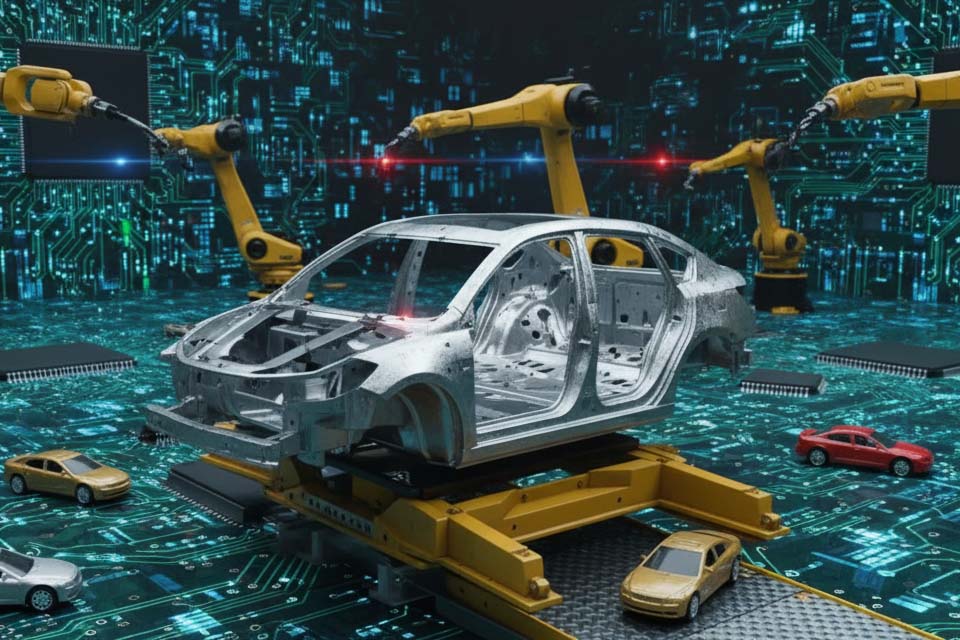Did you know the average modern car relies on over 3,000 semiconductor chips to keep everything running—from safety features to touchscreens? It’s wild, right? But here’s the thing. Currently, an imminent chip crisis 2025 is looming to put production lines on hold again. A geopolitical conflict over Chinese-owned chipmaker Nexperia this time is leaving car makers scrambling. Want to stay ahead of the curve and understand the ripple effects this could have? Hang around, we will see how such crisis is going to redefine the future of car makers and drivers again.
Root Causes of the Looming Chip Crisis
The looming disruption is not a repeat of the last, which was largely due to COVID-related production slowdowns across multiple manufacturers. But now, the crisis is mainly rooted in geopolitics. It centers on a single, crucial supplier—the Netherlands-based chip manufacturer Nexperia.
Here are the key factors driving the looming chip shortage:
➜ Trade Dispute. Nexperia is a Netherlands-based company, but it is wholly owned by the Chinese company Wingtech Technologies. Due to strained ties between the U.S. and China, the U.S. Commerce Department placed Wingtech under trade restrictions in December 2024.
➜ Dutch Government Intervention. On September 30, the Dutch government took control of Nexperia, citing “serious governance shortcomings” and a potential threat to safeguarding “crucial technological knowledge and capabilities” on Dutch and European soil. This action followed months of mounting pressure from the United States, although the Netherlands denied U.S. involvement.
➜ China’s Export Bans. In a significant escalation, the Chinese Ministry of Commerce instituted its own export controls on October 4. This ban prevents Nexperia China and its subsidiaries from exporting products manufactured in China, effectively choking a vital segment of the supply chain. Although most of Nexperia’s chips are made in Europe, about 70% are packaged in China before distribution.
Nexperia’s Role in Global Automotive Supply
Nexperia plays a disproportionately large role in the automotive industry, despite its $2 billion revenue in 2024. They are a high-volume supplier of fundamental chips like transistors and diodes. In fact, they control a 40% market share of these basic chips. The absence of even a single diode or chip can be enough to disrupt the manufacture of an entire vehicle. Nexperia produces over 6,000 automotive-related products and ships more than 110 billion products annually.
Automakers heavily relying on Nexperia’s chips include:
- General Motors (GM)
- Stellantis
- Mercedes-Benz
- Nissan Motor
- Volkswagen (warned workers of an imminent production stoppage)
- Toyota
- BMW
- Honda (suspended production at a Mexican plant)
Projected Impact on Automotive Production
Industry analysts predict this chip halt will hit various continents as soon as it happens, causing ripple effects worldwide. The Alliance for Automotive Innovation (AAI) warned that if the situation is not swiftly resolved, it will disrupt auto production in the U.S. and “many other countries”.
Imminent Timeline and Affected Automakers
According to manufacturer warnings and industry experts’ analysis, the U.S. car production may get seriously derailed as early as next month. For European manufacturers, production stoppages were already being scheduled by late October.
Some of the leading manufacturers in the world are actively monitoring and responding to the risk:
➜ General Motors (GM) and Stellantis: Both giants are well-versed in navigating the fluctuating availability of parts. This time, however, the stakes are particularly high.
➜ Mercedes-Benz: According to Mercedes-Benz CEO Ola Kaellenius, they are actively “scouring the world to look for alternatives” to secure their component supply.
➜ Nissan and Honda: Nissan reported having only enough chip supply to last until the first week of November. Honda has already suspended production at a plant in Mexico and started adjusting output at facilities in the U.S. and Canada.
➜ Volkswagen (VW): Europe’s largest carmaker warned its employees about potential delays, stating that an impact on production “cannot be ruled out in the short term”.
The Urgency of the “Weeks vs. Months” Gap
The real issue that fuels the urgency of this crisis is the tremendous discrepancy in timing. European Automobile Manufacturers Association (ACEA) indicated that automakers are left with mere weeks of chip supply. However, because of the time required for recertification, replacing Nexperia’s high-volume output through alternative, qualified suppliers is expected to take months.
This time discrepancy confirms that even if a full political resolution were achieved today, the global supply chain issues of extreme pressure is already there. If diplomatic efforts are delayed by just a few weeks, the resulting inventory shortage will inevitably lead to widespread, significant production halts globally. Even the ACEA Director General described this precarious supply gap as “alarming”.
Economic Fallout for Automakers & Consumers
What we are facing in the short term is a case of automakers trying to survive by making extreme decisions in response to a shortage. But the greater threat lies in repeating the crippling inflationary pressures that defined the last shortage.
Potential Scenarios for Automakers
To deal with the shortage, car manufacturers are already considering back-ups:
➜ Production Stoppages: Widespread production halts are the most likely short-term outcome. Manufacturers in countries like Brazil have already been warned that operations may have to stop within two to three weeks if the crisis is not resolved.
➜ Exploring Alternative Parts: Companies are frantically seeking new sourcing partners. GM teams are working “around the clock” to identify other sources to maintain operations. Even the electric vehicle maker Lucid Group is also utilizing its engineering teams to find alternatives to mitigate impacts on production schedules.
Historical Insight: The Cost of Scarcity
The lessons of the last chip crisis are obvious. When demand cannot be met by supply, prices explode and the burden is passed on to the consumer.
According to the data provided by the U.S. Bureau of Labor Statistics, prices of new cars increased by 21.2% in 2020-2023 during the shortage that followed the pandemic. This period of extreme scarcity inflated the cost of popular vehicles significantly. For example, a Ford F-150 truck that cost approximately $50,000 in 2020 was priced at about $60,602 in 2023. History suggests that unless a swift, political solution is achieved, consumers should prepare for a potential repeat of these severe inflationary pressures, coupled with limited vehicle availability.
Trade and Global Supply Chain Vulnerabilities
The Nexperia crisis clearly illustrates how globalized trade and specialized supply chains have become weaponized battlegrounds in international relations.
Crisis Distinction: Politics vs. Pandemic
It is crucial to understand the fundamental difference between the current situation and the crisis of the early 2020s. The previous automotive semiconductor shortage was an operational issue driven by manufacturing restrictions and COVID-related demand imbalances. This meant the solution was industrial—increasing capacity and building new facilities.
The 2025 crisis, however, is rooted entirely in political tensions—a trade dispute that required the Dutch government to invoke an obscure, Cold War-era law. Mercedes-Benz CEO Ola Kaellenius emphasized this distinction, stating that the current situation is different and requires a fundamental political solution.
Global Interdependence and Vulnerability
The ongoing standoff highlights the overt sensitivity of present-day production to international pressure. By depending on intricate network of global suppliers, a disruption at one point can ripple instantly across the globe. As Mercedes-Benz CEO Ola Kaellenius eloquently put it: “In a modern high-tech car, you have pretty much all five continents inside”.
The semiconductor supply chain is characterized by extreme geographic specialization. That’s why crucial manufacturing equipment often originates from allied nations like the Netherlands and Japan, while key materials, packaging, and assembly processes rely heavily on East Asia.
In fact, the Semiconductor Industry Association (SIA) confirms that foreign governments are aggressively providing hundreds of billions of dollars of financial incentives to seize and consolidate certain sectors of this ecosystem. That being said, it further increases global competition and further fragments supply control.
On the bright side, the Nexperia crisis (a political issue) can be a strong driver of policy change. This episode emphasizes the fact that supply chain resilience is a national security and economic priority. The automaker production disruption is expected to accelerate strategic initiatives in Europe, such as the full implementation of the European Chips Act, designed to boost local semiconductor production and decrease reliance on politically volatile global links.
Response Strategies by Automakers
Automakers and industry associations are now pursuing a rapid, two-pronged strategy. That’s aggressive short-term mitigation efforts coupled with intense political lobbying to force a diplomatic solution.
Immediate Actions by Automakers (Mitigation)
To cope with the immediate semiconductor shortage, manufacturers are implementing the following measures.
➜ Stockpiling and Inventory Checks: Companies are aggressively checking inventory levels and attempting to gain “full visibility” far down the supply chain, often reaching beyond their primary (Tier 1) suppliers to sub-tier providers.
➜ Adjustments in Production: Planning has already been replaced by active adjustment in some manufacturers. An example is Honda who has halted production at a single plant in Mexico and started to realign the output in the US and Canada to use up the available supply of components.
Industry Collaboration (Lobbying)
Industry bodies are mobilizing to secure diplomatic intervention, recognizing that a technical solution alone will take too long:
➜ AAI Urgency: The Alliance for Automotive Innovation (AAI), representing major U.S. automakers, is urgently lobbying for a resolution. CEO John Bozzella stated clearly: “If the shipment of automotive chips doesn’t resume quickly—it’s going to disrupt auto production in the U.S. and many other countries…We’re urging a quick resolution, so U.S. and global automaking remains on track”.
➜ MEMA Monitoring and Coordination: MEMA (Motor and Equipment Manufacturers Association) is keeping a close eye on the restrictions and working in partnership with the suppliers, trade associations, and policymakers to determine the extent of the overall impact.
➜ Government Negotiations: According to the industry insiders, eventually, companies and governments (including the U.S.) will have to negotiate with China to identify a diplomatic course of action. Something practical that will enable the supply of these crucial parts to resume.
Conclusion
Without a doubt, the chip crisis 2025 is a wake-up call. It’s a reminder to industries, governments, and innovators that tiny semiconductors hold massive power over our economy, technology, and security. As nations kick-start negotiations, supply chain resilience and joint solutions will be the determining factor in making it through this hard time. With policymakers doubling down on R&D, manufacturing incentives, and talent pipelines, the race isn’t just about chips. It is also about defining the future of global competitiveness. So be ready for a big, transformative ride!
—
Author: Maverick Steel is a writer and digital marketer who enjoys connecting the dots for strategy and engaging content. He spent 6 years in secondary education as a proud campus journalist, specializing in editorial and column writing. Holding a bachelor’s degree in Marketing Management, Maverick is also a devoted advocate for positive cyber citizenship and a certified pet lover. When he’s not busy writing, you can catch him hitting the gym or enjoying a matcha latte at the nearest aesthetic coffee shop.






